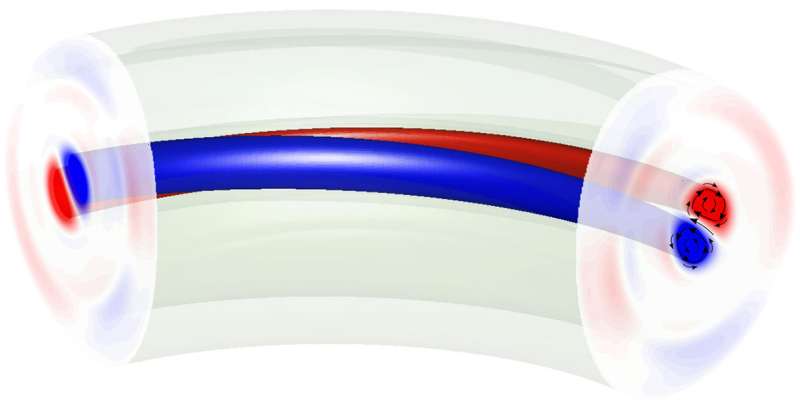Simulations of magnetically confined plasmas reveal a self-regulating stabilizing mechanism

The hot ionized gas called a plasma is confined in a bagel-shaped tokamak by a strong magnetic field, part of which is generated by a strong electric current flowing through the plasma. Periodically, a sawtooth instability occurs. It causes the central plasma temperature to abruptly drop and then recover in a sawtooth pattern. The instability limits how much current can be concentrated in the center of the plasma. However, there are types of tokamak plasmas for which a previously unknown mechanism, called magnetic flux pumping, limits the current in the plasma center so that it stays just below the sawtooth threshold. Scientists were puzzled by how this self-regulating mechanism works. The results of highly complex numerical simulations now suggest a possible answer.
The sawtooth instability can trigger other issues that lead to the deterioration or even loss of plasma confinement. Thus, hybrid scenarios in which magnetic flux pumping prevents the sawtooth instability are of interest. This is especially true for future large-scale fusion experiments, such as ITER. To extrapolate the accessibility and properties of hybrid scenarios to ITER, it is essential to understand the physics behind magnetic flux pumping. With the help of elaborate simulations, scientists are now able to find a possible explanation for this phenomenon.
The mechanism behind the magnetic flux pumping in the numerical simulations works as follows: if the central current profile is flat and if the central plasma pressure is sufficiently high, a quasi-interchange mode develops in the plasma's core. The quasi-interchange mode generates a large-scale helical flow of plasma that—almost like a mixer—constantly stirs the central plasma. At the same time, the magnetic field in the plasma core is deformed.
This is where a dynamo effect comes in. The dynamo effect plays an important role for many astrophysical phenomena as well as for the mechanism that maintains the Earth's magnetic field. It describes how a particularly swirly movement of an electrically conducting fluid can reinforce an existing magnetic field. In the case of the Earth's magnetic field, the fluid is the liquid part of the Earth's iron core. In the case of the hybrid tokamak scenario, the fluid is the hot plasma in the center of the tokamak. In the latter case, it is through a dynamo effect that the helical plasma flow and the helical deformation of the magnetic field combine to give a negative voltage that keeps the central current flat. By keeping the current in the plasma center flat, the sawtooth instability is prevented.
The numerical simulations also explain how this magnetic flux pumping regulates itself: The quasi-interchange mode is known to work best if the central current is at a certain threshold—which coincides with the threshold for the sawtooth instability. Whenever the flux pumping mechanism becomes too strong, it weakens the quasi-interchange mode and therefore its own drive. This is how the strength of the flux pumping is limited so that it keeps the central current just below the threshold for the sawtooth instability.
More information: S. C. Jardin et al. Self-Organized Stationary States of Tokamaks, Physical Review Letters (2015). DOI: 10.1103/PhysRevLett.115.215001
Journal information: Physical Review Letters
Provided by US Department of Energy




















